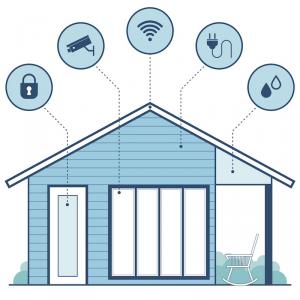
5 Top Trends for Smart Homes in 2017
Smart home technology is finally delivering on promises to make our homes more comfortable, convenient and secure. If you’re ready to incorporate one or more of these devices into your home, you’re in good company!
Some of today’s products still require a central control system, however, many operate from a home’s Wi-Fi signal. Another positive development is a growing number of partnerships between different providers, creating convenient integrations for a more cohesive system, often including voice-controlled assistants (like Amazon’s Echo products powered by the Alexa app, and Google Home).
What are the top trends this year?
1. Security — Long gone are the days when a home security system requires hardwired installation and monthly monitoring fees. Now, do-it-yourselfers can select from a seemingly unlimited range of options, including alarms, indoor/outdoor cameras, door/window sensors, motion detectors, and more.
Most likely, your most difficult task will be setting priorities and selecting among options. Be sure to pay attention to often-overlooked details, like camera resolution (day and night) and how videos are recorded (e.g., cloud storage may be free or upwards of $20 per month).
Also research the companion smartphone app to make sure it’s reliable, easy to use and offers the features you want (like text alerts).
2. Heating/cooling — From landmark Nest thermostats to leading competitors Ecobee and Honeywell, smart thermostats keep amping up their features and integrations. Now, Nest thermostats can be used to control home lighting, whereas the newest Ecobee4 includes a built-in Alexa-controlled speaker.
In addition to providing important energy savings, many homeowners can take advantage of energy rebates, incentives and other special offers. (The Nest, Ecobee and Honeywell sites all have links to find rebates in your area.)
3. Entertainment — Almost three-fourths of U.S. households now have a television connected to the Internet, either via a device integrated into the TV, or using separate devices like Roku, Apple TV, or Amazon Fire TV Stick. Popular uses include streaming video content (Netflix, YouTube, etc.) or for music-streaming purposes (Spotify, Pandora, etc.)
In a smart home, integration goes a step further, with the ability to monitor or control music throughout the home, or easily change the vibe from mellow to energetic (with a simple voice command to Alexa or Google).
4. Lighting — From basic on/off schedules, to dimming the lights to set a softer mood, or even changing lighting across a color range, today’s smart home options cover a broad gamut. One pioneer in the home lighting space is Philips Hue, which now markets a full spectrum of products at varying price points.
In addition to convenience and ambiance, smart home lighting can serve a security function. Scheduling options, for example, give the appearance that someone is home, while remote control makes it easy to flip on some lights at home when your quick dinner-out plans continue past sunset.
BeOn’s smart bulbs go one step further, automatically turning on if it hears your doorbell or alarm. They’ll also stay on if your power goes out and can even replicate your on/off lighting patterns when you’re not home.
5. Doors — Another collection of smart home products revolves around doors, including garage doors, entry door locks, video intercoms and doorbells. These products are primarily designed for security purposes, now incorporating numerous helpful conveniences.
With the newest August Smart Lock, for example, you can tell Siri to lock or unlock your door (deadbolt), whether you’re home or away. It also works with Nest. With Kevo’s newest Kwikset deadbolt, simply touch the deadbolt to lock/unlock it. The lock recognizes you by detecting your phone or a special fob on your keychain.
More to Explore
Other interesting devices for smart homeowners include water sensors (to alert you to flooding problems in your basement), robotic vacuums (now offering remote control apps), smart window shades (set a schedule and/or control them remotely), and indoor cameras specifically designed as baby monitors.
Getting smart about smart homes is one of the top challenges, particularly since new products and applications are always rolling out. Plus, partnerships and integrations can tip the scales in favor of one system over another.
Do your homework on the leading technology sites and read consumers’ reviews before deciding which product(s) to purchase. Once you’ve installed one device, it’s a safe bet you’ll be tempted to add more!
